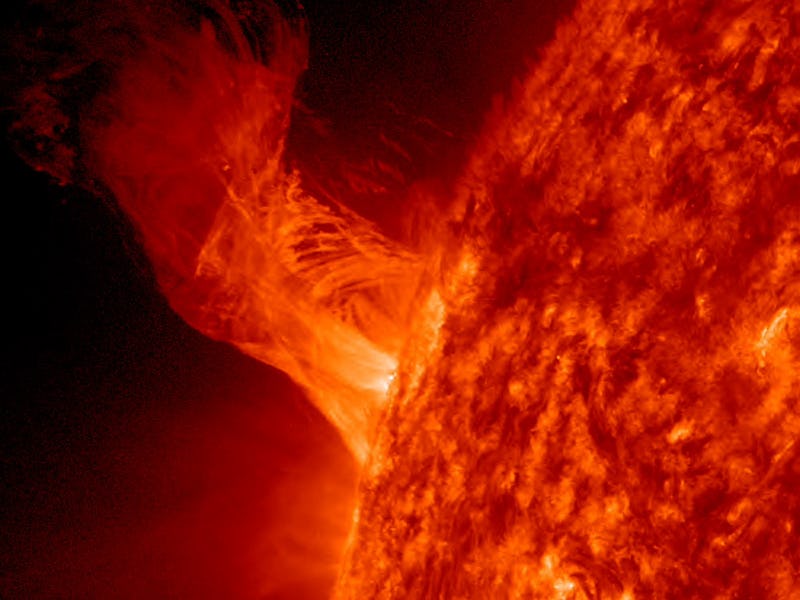By Disproving an Alien Conspiracy Theory, a BU Astronomer Made Spaceships Safer
Echoing radar signals had baffled researchers for years.

For the last 50 years, scientists have been stumped by an unknown phenomenon that occurs every morning at dawn: Radar signals echo for no apparent reason. Many have tried and failed to explain the abnormality, which was frequently and vociferously attributed to aliens by the conspiracy minded. Now, researchers from Boston University appear to have solved the puzzle by accident. The echoes are being caused by the sun.
Meers Oppenheim, the Associate Chair of astronomy at Boston University, and his research team used a computer simulation to mimic the behavior of particles in the Earth’s atmosphere. They found that the sun’s radiation was creating the echo environment. Inverse spoke to Oppenheim, to learn just how they disappointed all those alien truthers.
Aside from all the talk about aliens, what did most scientists think was causing this before?
The most common hypothesis was that it was caused by changes in the ionospheric density, so pressure gradients — just like winds are caused by pressure gradients. And there are other waves in the ionosphere that are caused by pressure gradients; it was thought that these might also be. The problem is that in this region the pressure gradients are very weak, there’s not a lot of rapid change in the plasma pressure in this region. And the pressure gradients come and go, but the echoes never seemed to follow them. So that was the standard hypothesis. There were some other more clever or different hypotheses I’d hear. There was a thought that maybe you were essentially vibrating the entire field line like a guitar string, but this didn’t really hold up to well. There’s enough dissipation that it wouldn’t vibrate very much. Like a guitar string someone was touching.
So you conducted this study with the theory in mind that the sun could be causing these conditions?
We had this hypothesis that it was these photo electrons driven by extreme ultraviolet light that kicked the electrons really hard, and somehow their energy gets into the ion plasma density. But the problem is how do you get the energy from those photoelectrons to waves of the right wavelength in order to reflect the radars? Because the radars are very picky, very sensitive in what they observe. They have to see disruptions that match the wavelength [almost] exactly. At that scale, you expect stuff to diffuse rapidly, to smooth itself out very quickly, and yet these signals are ubiquitous and pretty strong.
Was the sole purpose of the computer model you created to determine what was causing these echoes?
The basic model simulator was in existence, and then I had to add the ability to mimic these photoelectrons. That was the new bit. You know, if I’m on an airplane and I need to get work done and someone asks what I do I say I’m a computational plasma physicist because that shuts down the conversation really fast. If I say I’m an astronomer they start telling me they’re a Sagittarius and everything.
This doesn’t prove absolutely conclusively that the sun is causing the echoes. How sure are you that you’re on the right track?
The evidence is pretty strong. We have the fact that the [echoes] go away with the solar eclipse, they go away at night. And with a solar flare, they flare up and become stronger. So there’s that. And we don’t just match the fact that we get the signals, we match the structure of the reflection. The radars don’t only return signal strength, they have all this detailed information — Doppler strength, Doppler shifts…. It’s pretty bloody good. There’s still one mystery though, which is the substructuring. If you look at picture of echoes, there’s regions of stronger and less-strong echoes, you can see that why that exists, we still don’t know. It may be that that’s a reflection of gravity waves that flow through the atmosphere, but we don’t know.
This new data could help us better understand atmospheric tides. Why is that important? What practical implications could it have?
There are several reasons, but one of the most important reasons is a simple thing, it’s a drag on spacecraft. We have all these spacecraft that start just a few kilometers above this. You find spacecraft up at around 180,000 kilometers, and how long they can persist at an altitude depends on the drag they experience. So there’s a whole industry trying to model this precisely. We want to be able to predict where debris will be as well, so it doesn’t hit this trillions of dollars of spacecraft up there.
Due to the nature of these echoes and all the rumors about them, I have to ask — do you believe in extraterrestrial life?
I don’t believe much has visited me … I’ve seen nothing. But do I believe there might be extraterrestrial life anywhere in the universe? It’s a really, really big universe, and it would be really disappointing to not have any. But so far, not much evidence.
This interview has been edited for length and clarity.